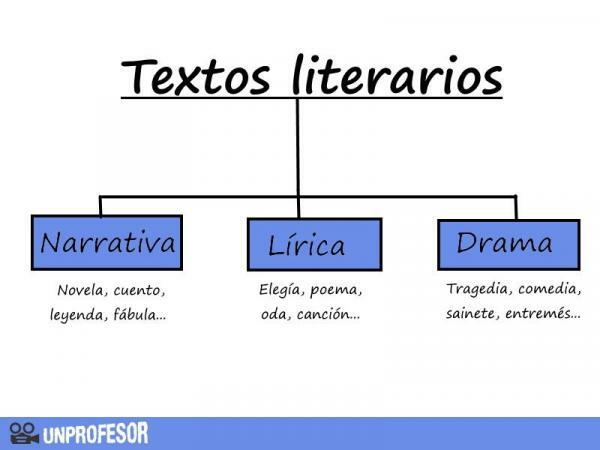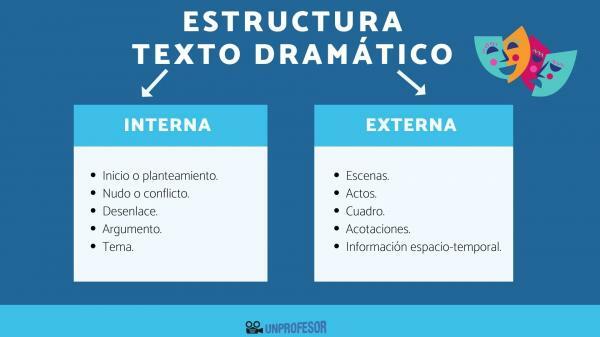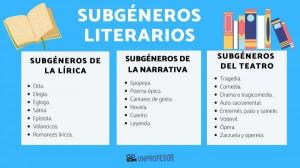STRUCTURE of the DRAMATIC text: internal and external

Each type of literary text has peculiarities that make it unique and easy to recognize. And it is not the same to be before a narrative text, a lyrical or a dramatic one; Although they have similarities, they also have very notable differences that you deserve to know. In this lesson from a TEACHER we are going to discover what the dramatic text structure So that, thus, you can understand how this type of literary text is organized and the most prominent elements that make it up. We started!
Index
- What is a dramatic text and its characteristics?
- What is the structure of a dramatic text?
- External structure of a dramatic text
- The 3 units of classical theater
What is a dramatic text and its characteristics?
The drama It is one that has a type of literary text that is characterized by the use of dialogues, the importance of the action, the participation of various characters and its structure. Because the structure of the dramatic text is totally different from that of the lyric or narrative, since this genre has special needs, since it is intended to be played by actors and actresses on a stage.
It is important that we know that the dramatic genre is not the same as the theater: the dramatic genre is the literary genre itself, that is, the literary text in which we find the written work; on the other hand, the theater implies the other factors necessary for the representation (actors, scenery, physical space, etc.).
A dramatic text has elements that make it unique and particular. One of them is that its purpose is not to be read, but be interpreted; another is that it always focuses on the character conflict, a type of conflict that occurs through dialogue and the interaction between the different characters that are part of the work.
In this type of literary text there is no presence of the narrator, as it happens in the narrative, nor of the "poetic self", as it usually happens in the lyric. In these texts, the playwright disappears and it is his characters who interpret and communicate his message.

What is the structure of a dramatic text?
In order to know the structure of the dramatic text, first we must bear in mind that in all types of text there are two structures: the internal and the external. Therefore, we will start by talking about the internal structure of these texts to analyze their most prominent elements.
This type of structure refers to how the content is organized of the work itself, that is, the story that the author wants to convey. In order to present all the events and conflicts of the characters, the playwright usually follows the classical structure:
- Start or approach. It is the initial situation in which the characters are before the plot takes place.
- Knot or conflict. The problem that makes the protagonist of the work have to start to activate and try to solve it. This part of the play culminates in a climax, that is, a peak moment in which everything explodes.
- Outcome. It is the final situation, the return to "normality", although that normality will not be the same as in the beginning. The characters have experienced a catharsis and, normally, they have experienced a change in their life and in their reality.
The dramatic work does not have to follow this order, but it is usually structured in this way so that the story is clear and the viewer understands better what he has seen. It may be that the work begins "in media res", that is, right in the conflict or that it begins at the end and the facts begin to be reconstructed. Be that as it may, every dramatic work has this internal structure.
Other elements of the internal structure of the dramatic text
Although the organization of the story itself is the classical structure, there are also other elements of the internal structure such as:
- Plot of the work. The plot is the order of the scenes that has been chosen to present the work. All those scenes together are the ones that explain the story to us.
- Theme of the work. This element also refers to the internal structure because it speaks of the content of the work itself. The theme is what the work is about, something that is not usually known until the end is reached and everything that has been seen is analyzed.
Example
The theme is not the same as the argument because, for example, in Romeo and Juliet, a classic Shakespearean play, the main theme is true love, although there are other sub-themes such as envy, dishonor, rivalry, etc.
Instead, the plot would be: Romeo meets Juliet at a palace party and falls in love with her. Juliet reciprocates, but they are both members of rival families. The couple tries to defend her love despite the conflict in their families, but finally Juliet will fake her own suicide in order to marry Romeo. Romeo, who will not know that Juliet is not really dead, will kill himself so that her love may be eternal. Juliet, seeing that Romeo is killed, decides to kill herself too.
As we can see, the theme and the argument are different elements.
External structure of a dramatic text.
We will now talk about the structure of the dramatic text, paying attention to the external elements who are in charge of organize the play. The elements that make up this dramatic structure are:
- Scenes. The theatrical works are divided into different scenes.
- Acts. The accumulation of various scenes creates the acts. Formerly, there were 3 acts that Aristotle postulated in his PoeticsHowever, today they can be more or less. The acts are not arbitrary: the playwright organizes the different phases of the conflict in the different acts so that, thus, the development of the play can have rhythm and coherence.
- Picture. They are the minor dramatic units that the playwright follows in order to better divide the action. The paintings are usually easily recognized because they imply a change of scenery, be it props, light, costumes...
Other elements of the structure of the dramatic text
In addition to the elements that we have just analyzed, you should know that in the external structure of dramatic texts there are also other elements to mention:
- Annotations. They are the author's indications and the purpose of which is to help the play to be put on stage. These notations are subjective and practical, such as "We are in a park, there is a bench and a tree" or "Enter Character 1 with a dark raincoat and sunglasses", and so on.
- Spatio-temporal information. This information must be given if space or time is changed in the text. For example, "On a beach in Barcelona, August" or "In a forest in the Pyrenees, December". Obviously, both pieces of information are essential to be able to present the work well contextualized.

The 3 units of the classical theater.
To conclude with this lesson that talks about the structure of the dramatic text, it is important to mention the rule of 3 dramatic units of classical theater, since they were the ones that prefixed the works that appeared in the origin of the theater.
This classical rule is found in Aristotle's Poetics. In this text it was defended that a dramatic text had to comply with:
- Unity of action. That is to say, that there was only one conflict and that it was the engine of the entire work.
- Unity of place. That all the work took place in the same place, for example, in a forest, in a palace, etc.
- Time unit. And that the play took place at the same time and that, furthermore, there were no time jumps like "Al día next "or flashbacks, but everything happened in the same time plane, during a meal, a dance...
As you can imagine, these 3 rules were difficult to translate to paper and, in fact, except for classical French playwrights, hardly anyone else followed these precepts in a minute way.
The great change of the theater occurred in the XVI and XVII with the irruption of the Baroque theater. In fact, in Spain it was Lope de Vega and his New art of making comedies who opted for another type of theater, away from these Aristotelian norms and which gave the playwright greater freedom of creation. Lope defended breaking with the rule of the unity of place and time, although he defended the rule of action to avoid too convoluted works.
Lope led the way to Calderón de la Barca, playwright who brought the theater to its maximum splendor and who, really, laid the foundations for modern theater, thus breaking its link with the Greek tradition.
If you want to read more articles similar to Structure of the dramatic text, we recommend that you enter our category of Literary concepts.
Bibliography
- Castedo, M. (1989). Construction of a dramatic text: Report of an experience. Reading and life, 10 (1).
- García Barrientos, J. L. (2006). Principles and utilities of a theatrical theory of the dramatic text.
- Castagnino, R. H. (1981). Theories on dramatic text and theatrical representation. Editorial Plus Ultra.



![All SUBGENERS of the DRAMA genre: older and younger [SUMMARY !!]](/f/8066bbe44ef24320ce85203d444172b6.jpg?width=300&height=200)